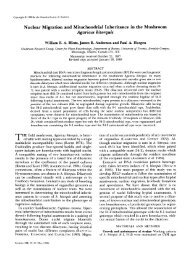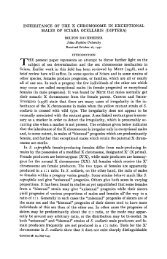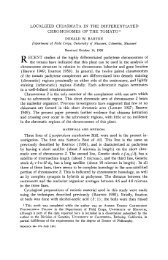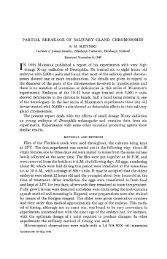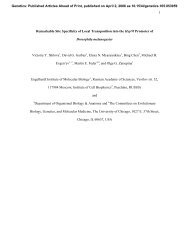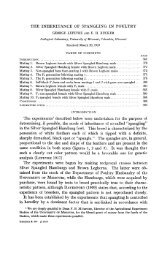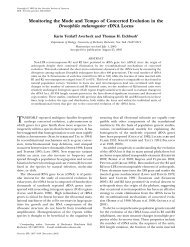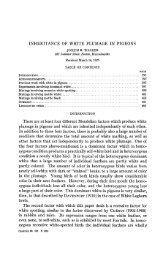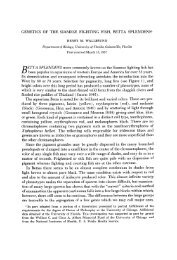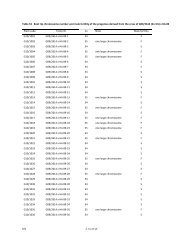abstracts of papers presented at the 1962 meetings - Genetics
abstracts of papers presented at the 1962 meetings - Genetics
abstracts of papers presented at the 1962 meetings - Genetics
You also want an ePaper? Increase the reach of your titles
YUMPU automatically turns print PDFs into web optimized ePapers that Google loves.
ABSTRACTS 95 7<br />
tion, respectively, produced by <strong>the</strong> addition <strong>of</strong> a Y chromosome to <strong>the</strong> various inversion hetero-<br />
zygotes is as follows: sc7/+ (26.3, -16.2), BM'/+ (18.5, +10.8), 65/+ (25.9, -9.7), AB/+<br />
(29.3, +M.5), dl-M/+ (50.6, -25.3), scS/+ (19.2, f37.3). Since <strong>the</strong> effect <strong>of</strong> <strong>the</strong> Y on cross-<br />
ing-over is not correl<strong>at</strong>ed with its effect on disjunction, but depends on <strong>the</strong> loc<strong>at</strong>ion <strong>of</strong> <strong>the</strong> X-in-<br />
version, it is proposed th<strong>at</strong> associ<strong>at</strong>ions between <strong>the</strong> X and Y, th<strong>at</strong> lead to exceptions, occur sub-<br />
sequent to exchange <strong>at</strong> distributiue pairing, and th<strong>at</strong> <strong>the</strong>y involve only those X chromosomes<br />
th<strong>at</strong> have not particip<strong>at</strong>ed in exchange with each o<strong>the</strong>r.<br />
HARDON, JAAP J., University <strong>of</strong> California, Davis, California: Self-incomp<strong>at</strong>ibility and selfcomp<strong>at</strong>ibility<br />
in Solanum pennellii Cor. in rel<strong>at</strong>ion to its unil<strong>at</strong>eral comp<strong>at</strong>ibility with Lycopersicon<br />
esculentum Mill.-Self-incomp<strong>at</strong>ibility (SI) controlled gametophytically by S alleles <strong>at</strong> one<br />
locus has been discovered in two accessions (hereafter design<strong>at</strong>ed as SI S.P.) <strong>of</strong> Solanum pennellii.<br />
The original living accession (SF S.P.) is completely self-fertile (SF). Pollen tubes <strong>of</strong><br />
incomp<strong>at</strong>ible m<strong>at</strong>ings cease growth in <strong>the</strong> uppermost 3 mm <strong>of</strong> styles. All three collections can be<br />
hybridized with Lycopersicon esculentum but only with <strong>the</strong> l<strong>at</strong>ter as female parent. All individuals<br />
<strong>of</strong> F, and F, L. esculentum x SI S.p. exhibit <strong>the</strong> strict SI <strong>of</strong> <strong>the</strong> pennellii parent. Each<br />
F, consists <strong>of</strong> two intercomp<strong>at</strong>ible classes. In all preceding aspects <strong>the</strong> behavior is <strong>the</strong> same as<br />
th<strong>at</strong> <strong>of</strong> hybrids between L. esculentum and SI species <strong>of</strong> Lycopersicon. F, L. esculentum x SF<br />
S.p. is self-fertile and a backcross to SI S.p. segreg<strong>at</strong>ed approxim<strong>at</strong>ely 1 SI: 1 SF. These and o<strong>the</strong>r<br />
results support LEWIS and CROWE'S (1958) model <strong>of</strong> stepwise mut<strong>at</strong>ion leading from SI (as in<br />
SI S.P.) via intermedi<strong>at</strong>e SF (as in SF S.P.) to SF (as in L. esculentum).-The following facts<br />
bear on <strong>the</strong> rel<strong>at</strong>ionship with unil<strong>at</strong>eral crossing behavior. No plants <strong>of</strong> F, or F, L. esculentum x<br />
SI S.p. were comp<strong>at</strong>ible as stamin<strong>at</strong>e parents with any SI S.p. nor as pistill<strong>at</strong>e parents with L.<br />
esculentum. The first backcross (30 plants) <strong>of</strong> <strong>the</strong> same hybrid to SI S.p. behaved in <strong>the</strong> same<br />
fashion. The results suggest th<strong>at</strong> <strong>the</strong> unil<strong>at</strong>eral barrier is regul<strong>at</strong>ed to some extent by SI but also<br />
by additional, perhaps polygenic, control. (Support by grant G-10704 <strong>of</strong> <strong>the</strong> N<strong>at</strong>ional Science<br />
Found<strong>at</strong>ion is acknowledged.)<br />
HAWTHORNE, D. C., University <strong>of</strong> Washington, Se<strong>at</strong>tle, Wash.: Supersuppressors in yeast.-<br />
Cases are known in Drosophila, Neurospora, and bacteria in which <strong>the</strong> effects <strong>of</strong> mutant genes<br />
<strong>at</strong> two or more loci are suppressed by a single suppressor gene. In yeast, Saccharomyces cereuisiae,<br />
several supersuppressors have been found, each with a nearly identical action spectrum<br />
which includes mutants for adenine, arginine, histidine, isoleucine, leucine, lysine, tryptophane,<br />
tyrosine, and uracil requirements and a genetic petite condition. Although not locus specific,<br />
<strong>the</strong>refore, <strong>the</strong> suppressors are specific in th<strong>at</strong> <strong>the</strong>y will restore to normal or near-normal <strong>the</strong><br />
mutant character associ<strong>at</strong>ed with only a fraction <strong>of</strong> <strong>the</strong> different heteroalleles <strong>at</strong> a given locus.<br />
Altoge<strong>the</strong>r <strong>the</strong> super-suppressors suppress <strong>the</strong> phenotypic expression <strong>of</strong> about one fourth <strong>of</strong> all<br />
<strong>the</strong> genes examined. Because <strong>of</strong> <strong>the</strong> frequency as well as <strong>the</strong> diversity <strong>of</strong> <strong>the</strong> suppressible mutants<br />
it is thought th<strong>at</strong> <strong>the</strong>se mutants might well represent a class <strong>of</strong> enzyme aberr<strong>at</strong>ions which<br />
would respond to some slight change in <strong>the</strong> physiology <strong>of</strong> <strong>the</strong> cell caused by <strong>the</strong> suppressor gene.<br />
HECHT,<br />
A., Washington St<strong>at</strong>e University, Pullman, Wash.: Znactiu<strong>at</strong>ion <strong>of</strong> an incomp<strong>at</strong>ibility<br />
substance by means <strong>of</strong> high temper<strong>at</strong>ure tre<strong>at</strong>ments.-Under normal field growing conditions<br />
as well as under similar conditions in <strong>the</strong> labor<strong>at</strong>ory it has been observed th<strong>at</strong> pollen tubes <strong>of</strong><br />
Oeno<strong>the</strong>ra organensis do not even enter <strong>the</strong> tissues <strong>of</strong> stigmas which have been self-pollin<strong>at</strong>ed.<br />
Pollin<strong>at</strong>ion with genetically comp<strong>at</strong>ible pollen results in <strong>the</strong> germin<strong>at</strong>ion <strong>of</strong> many more <strong>of</strong> <strong>the</strong><br />
pollen grains and <strong>the</strong>ir easy penetr<strong>at</strong>ion into <strong>the</strong> tissues <strong>of</strong> <strong>the</strong> stigma and style. Earlier experi-<br />
ments involving stylar grafts have indic<strong>at</strong>ed th<strong>at</strong> <strong>the</strong> inhibition <strong>of</strong> <strong>the</strong> incomp<strong>at</strong>ible pollen oc-<br />
curs both in stigma and style, but th<strong>at</strong> <strong>the</strong> reaction is strongest in <strong>the</strong> stigma.-If styles are ex-<br />
cised <strong>at</strong> <strong>the</strong>ir junction with <strong>the</strong> ovary, and are <strong>the</strong>n tre<strong>at</strong>ed <strong>at</strong> temper<strong>at</strong>ures just below wh<strong>at</strong> will<br />
kill <strong>the</strong>ir sells (5Oo-57"C), some change occurs reducing <strong>the</strong> intensity <strong>of</strong> <strong>the</strong> incomp<strong>at</strong>ibility<br />
reaction: after approxim<strong>at</strong>ely five minutes <strong>at</strong> this temper<strong>at</strong>ure, whe<strong>the</strong>r <strong>the</strong> styles are immersed





